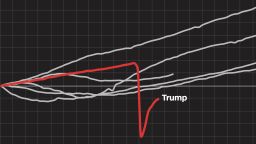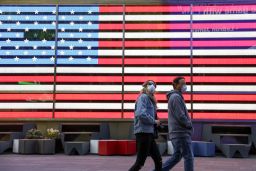The US economy in the summer recovered much of the historically enormous ground it lost in the spring, expanding at the fastest rate on record in the third quarter, the Commerce Department reported Thursday.
Still, the recovery remains incomplete. The economic crisis that Covid-19 brought on is far from over, and the pandemic threatens to plunge the American economy into turmoil again as infection numbers continue to rise rapidly across the country.

The third quarter, however, was one for the record books. Gross domestic product — the broadest measure of economic activity — grew at an annualized and seasonally adjusted rate of 33.1% between July and September. This was a faster rate of expansion than economists had predicted.
It was also the fastest growth rate since the government began to track quarterly GDP data in 1947. It represented a sharp, albeit partial, recovery from the prior three months, when the economy contracted at an annualized, seasonally adjusted rate of 31.4%.
The government reports GDP as an annualized rate, which assumes that the growth rate from one quarter to another will continue for a full year. This practice makes it easier to compare data over time.
But with the unprecedented economic woes of the pandemic, some economists suggest actual GDP growth is the better metric to tell the story of America’s economy.
Looking at the quarterly data alone, GDP grew 7.4% from the second to the third quarter, compared with a 9% decline between the first and second quarter.
The rapid growth reflects the restarting of the economy after the spring lockdown, but America is not out of the woods yet.
“This is going to be seized upon by both ends of the political spectrum as either evidence of the strength of the post-lockdown economic rebound or a cursory warning that the gains could be short-lived,” said Aberdeen Standard Investments senior global economist James McCann in emailed comments.
There’s truth to both sides: the economy did partially rebound as lockdown restrictions eased. But the big boost is behind us and Covid-19 infections are rising again. On top of that, Congress remains at an impasse on another stimulus package.
Even though the third quarter’s annualized growth rate was a larger number than the decline in the second quarter, it doesn’t mean the economy has fully bounced back.
The drop between April and June was so severe that even though the third quarter increase was large, it’s starting from a much lower base. Comparing the size of the economy in the third quarter to the pre-pandemic fourth quarter of last year hammers this home: Overall, economic activity is still $670 billion, or 3.5% below where it was at the end of 2019.
As we move on from the violent swings in economic activity between March and September, “the sober realities of the economic situation will become more apparent,” said Brian Coulton, chief economist at Fitch Ratings.
He expects growth to slow sharply again: “we are still a long way from normalization and the surge in the virus cases means social distancing and all its related economic implications are here to stay.”
Not yet back to normal
The National Bureau of Economic Research said the pandemic recession started in February. It defines a recession as the period between the peak of economic activity and its nadir. Whether the recession is officially behind us isn’t clear yet. If it is, it would have been much shorter than the average downturn.
But economists worry that the economy is slowing down again in the final three months of the year. Meanwhile, Covid-19 infections are spiking again and worries about renewed lockdown restrictions that could deepen the pandemic recession. In Europe, rising infection rates have already led to tighter rules.
The Back-to-Normal Index created by Moody’s Analytics and CNN Business shows economic activity has barely changed in weeks.
Millions of people are still unemployed and rely on government benefits to make ends meet. As of September, the US labor market was still down 10.7 million jobs compared with pre-pandemic times.
Personal income fell in the third quarter, decreasing $541 billion following a $1.45 trillion increase in the second quarter, as the effect from pandemic programs, including stimulus checks waned.
Supplemental unemployment benefits of $600 per week expired at the end of July and have only partially been matched by an executive order signed by President Donald Trump.
As the impact of those stimulus programs wanes, it could hold back the recovery. That’s because the US economy relies heavily on consumer spending.

Between July and September, a big increase in consumer spending, particularly on health care, food services and accommodation, as well as cars, drove the economy’s bump. Overall, though, spending on services remains well below its pre-pandemic high.
On the other end of the spectrum, federal, state and local government spending decreased and the country imported more foreign goods, which is subtracted from GDP.
Economists expect much more modest growth — far below the 10% annualized mark — in the final quarter of the year. It will take until the end of 2021 for economic output to get back to where it was before the virus hit, said Gregory Daco, chief US economist at Oxford Economics.






















